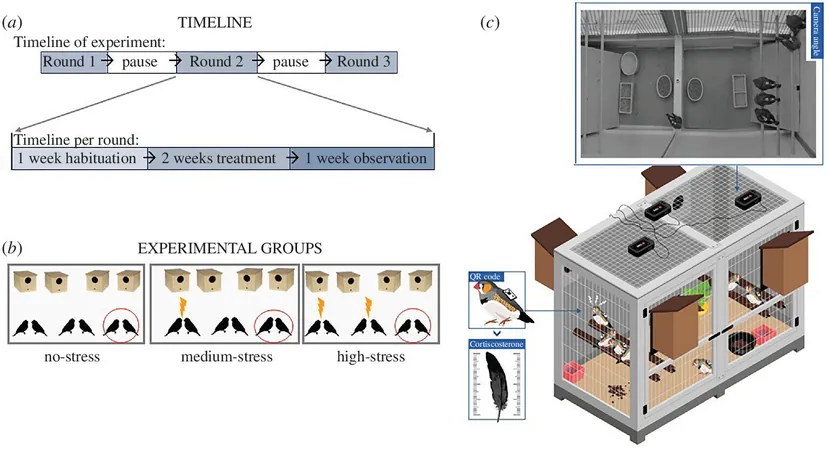
The Shocking Truth: Stress is Contagious Among Animals!
2024-11-13
Author: John Tan
In a world where urbanization and climate change are rapidly transforming animal habitats, the impact of these changes on wildlife has drawn increasing concern.
Animals are now more than ever exposed to various stressors, which raises an intriguing question: how do stress levels in one animal affect its social counterparts? A groundbreaking study sheds light on this phenomenon, revealing that stress isn’t just an individual burden but a collective experience within animal communities.
Hanja Brandl, a behavioral biologist from the University of Konstanz, and her collaborator Damien Farine from the Australian National University, recently conducted a pioneering series of experiments involving 96 zebra finches.
Their findings, published in the prestigious journal *Proceedings of the Royal Society B: Biological Sciences*, could change our understanding of animal behavior amidst environmental stress.
Over three rounds of experimentation lasting four weeks each, specific zebra finches were subjected to various stress-inducing disruptions.
Cameras meticulously documented the behavior of not only those affected but also the uninvolved finches in the same social group.
The researchers also measured corticosterone levels—an essential stress hormone—in the birds’ tail feathers, adding another layer of insight into the stress response.
Stress is Contagious!
The study revealed a startling conclusion: stress responses among individual zebra finches can ripple through their social groups, influencing even those who have not directly encountered stressors.
According to Brandl, “In groups where a larger proportion of birds experiences stress, we observed this effect even more strongly.” This is not just a curious observation but a significant insight into animal behavior.
One of the most alarming results showed that unexposed finches in stressed groups exhibited reduced activity levels.
This could lead to diminished exploration of their environment and restricted movement, ultimately impacting their access to vital resources.
"For birds in the wild, this could prevent them from gathering enough food or finding suitable nesting areas,” Brandl warns.
Beyond mere activity levels, the presence of stressed members in a group altered the social behaviors of unaffected finches.
These individuals formed fewer new social bonds and relied more on existing relationships, indicating a withdrawal from social interaction during high-stress group dynamics.
Farine emphasizes the implications of these findings: “This means that stress in a group could impact its social cohesion.
At the same time, a reduction in weak social ties would, in turn, reduce the risk of stress transmission.” The cascading effects of stress transmission could compromise the integrity of social structures within animal populations, raising concerns about how such dynamics might influence their survival and reproductive success.
As we move forward in a changing world, understanding the implications of stress on animal communities has never been more crucial.
This research not only opens the door to further investigations into animal behavior but also underscores the urgent need to consider the psychological impacts of habitat alteration in wildlife conservation efforts.
Stay tuned for more eye-opening revelations in the animal kingdom!
Could stress be more than just a personal issue? The answer might just reshape how we view wildlife interactions.

 Brasil (PT)
Brasil (PT)
 Canada (EN)
Canada (EN)
 Chile (ES)
Chile (ES)
 España (ES)
España (ES)
 France (FR)
France (FR)
 Hong Kong (EN)
Hong Kong (EN)
 Italia (IT)
Italia (IT)
 日本 (JA)
日本 (JA)
 Magyarország (HU)
Magyarország (HU)
 Norge (NO)
Norge (NO)
 Polska (PL)
Polska (PL)
 Schweiz (DE)
Schweiz (DE)
 Singapore (EN)
Singapore (EN)
 Sverige (SV)
Sverige (SV)
 Suomi (FI)
Suomi (FI)
 Türkiye (TR)
Türkiye (TR)